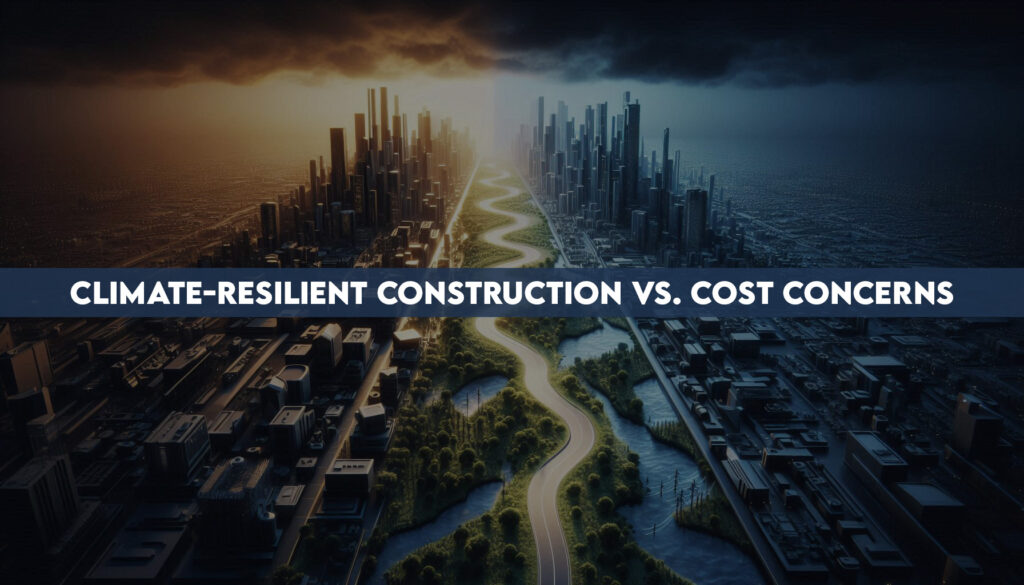Have you ever stopped to think about the buildings around you? Not just their color or design, but how they’re built to stand the test of time? In an age where our planet is sending us clearer signals than ever before from scorching heatwaves to relentless downpours and powerful storms a critical question emerges: should every new building, every new road, every new piece of infrastructure be designed to withstand the future’s climate challenges, even if it means a higher price tag upfront?
It’s a question that brings together engineers, economists, policymakers, and ordinary citizens, all trying to find the sweet spot between what’s affordable today and what’s absolutely necessary for tomorrow.

The Shifting Sands Beneath Our Feet: Why “Business as Usual” Won’t Cut It
For decades, we’ve built based on past weather patterns. We looked at historical data, designed for the “average” conditions, and largely assumed those conditions would continue. But the world has changed. Climate change isn’t a distant threat; it’s here, now, impacting our communities in undeniable ways.
Think about it:
- Rising Sea Levels: Coastal communities face the very real threat of permanent inundation.
- More Intense Storms: Hurricanes, cyclones, and typhoons are packing more punch, leading to widespread destruction.
- Extreme Heat: Cities are becoming urban ovens, demanding better cooling solutions and materials that don’t trap heat.
- Flash Flooding: Even inland areas are experiencing unprecedented deluges, overwhelming traditional drainage systems.
- Drought and Water Scarcity: Affecting everything from agriculture to the very foundations of buildings that rely on stable ground.
The damage isn’t just to property; it’s to lives, livelihoods, and the fabric of our communities. When a major flood wipes out homes and businesses, the human cost is immeasurable, and the economic recovery can take years, even decades.
Also Read: Top 5 Estimating Tools for NZ Contractors 2025
What Exactly is “Climate Resilient Construction”?
It sounds a bit technical, doesn’t it? But at its heart, climate-resilient construction simply means building smarter. It’s about designing and constructing buildings and infrastructure to better withstand the impacts of climate change, reducing damage, and ensuring they can continue to function when extreme weather hits.
This can involve a whole range of strategies:
- Elevated Foundations: Lifting buildings above projected flood levels.
- Durable Materials: Using materials that can resist high winds, intense heat, or prolonged moisture.
- Green Roofs and Permeable Paving: Helping to manage stormwater runoff and reduce the urban heat island effect.
- Improved Drainage Systems: Designing for heavier rainfall events to prevent flooding.
- Passive Cooling and Heating: Using clever architectural designs to reduce reliance on energy-intensive air conditioning and heating.
- Stronger Structural Design: Reinforcing buildings to withstand stronger winds and seismic activity.
- Nature-Based Solutions: Integrating natural elements like mangroves or wetlands as buffers against coastal erosion or storm surges.
It’s about foresight, about anticipating future challenges rather than just reacting to them.
The Elephant in the Room: The Cost Question
This is where the debate gets really interesting. Naturally, making buildings more robust, using specialized materials, and implementing advanced designs often costs more upfront. A developer might look at the plans for a climate-resilient building and see a higher initial investment compared to a conventional one.
So, the burning question is: Should we mandate climate-resilient construction for all new projects, even if it means a higher price tag?
Let’s explore the arguments from both sides.
The Argument Against Higher Upfront Costs: “We Can’t Afford It”
For some, the immediate concern is economic.
- Affordability Crisis: In many parts of the world, housing is already expensive. Adding more costs, even for good reason, could push homes further out of reach for many families.
- Economic Competitiveness: Businesses might argue that higher construction costs could make a region less attractive for investment, potentially slowing down development and job creation.
- Short-Term Focus: Politicians and developers often operate on shorter timelines, focusing on immediate returns or electoral cycles rather than long-term resilience. The benefits of climate-resilient design might not be fully appreciated for years, or even decades.
- Budget Constraints: For public projects, like roads or hospitals, adding significant costs might mean fewer projects can be undertaken, or existing services might need to be cut.
It’s a valid concern. We need to be mindful of the economic realities and ensure that solutions are equitable and don’t disproportionately burden certain communities or individuals.
The Argument For: “We Can’t Afford Not To”
This is where the long-term perspective comes into play. Advocates for mandatory climate-resilient construction argue that while the upfront cost might be higher, the cost of inaction is far, far greater.
- Avoiding Catastrophic Losses: Imagine a major hurricane hitting a city. If buildings are resilient, the damage is minimized, fewer lives are lost, and the economic disruption is less severe. The cost of rebuilding after a disaster – often in the billions of dollars – dwarfs the extra cost of building resiliently in the first place. Think about the rebuilding efforts after Hurricane Katrina or the recent floods in various parts of India. These are staggering figures.
- Reduced Insurance Premiums: Insurance companies are increasingly factoring climate risk into their premiums. Resilient buildings are less risky, potentially leading to lower insurance costs over time for homeowners and businesses. This can offset some of the initial investment.
- Increased Property Value: A resilient home or business is inherently more valuable in a changing climate. Buyers will increasingly seek properties that offer safety and security from environmental threats.
- Business Continuity: For commercial buildings, resilience means less downtime during and after extreme weather events. This ensures businesses can get back on their feet faster, protecting jobs and local economies.
- Public Safety and Health: Resilient infrastructure, like hospitals and emergency services, remains operational during crises, saving lives and providing essential care. Beyond that, things like effective drainage prevent the spread of waterborne diseases after floods.
- Long-Term Savings on Maintenance and Repairs: Buildings designed for resilience often require less maintenance and fewer repairs over their lifespan because they are built to withstand stresses.
- Environmental Benefits: Many climate-resilient strategies, like green roofs or passive cooling, also offer environmental benefits such as reduced energy consumption and improved air quality.
- Future-Proofing: Building resiliently today means we won’t have to retrofit or rebuild at much greater expense down the line. It’s an investment in the future, safeguarding our communities for generations.
- Ethical Responsibility: As a society, do we have a moral obligation to protect future generations from the consequences of climate change? Building resiliently is a tangible way to fulfill that responsibility.
Consider the example of Japan, a country highly prone to earthquakes and tsunamis. Their rigorous building codes, which mandate seismic resilience, mean that even powerful earthquakes often result in far less structural damage than they would in areas with less stringent regulations. While the construction is more expensive, the long-term savings in lives and rebuilding costs are undeniable.
Finding the Balance: How Do We Move Forward?
The answer isn’t a simple “yes” or “no.” It’s about finding smart solutions and frameworks that encourage or mandate resilience without crippling economies.
- Smart Regulations and Building Codes: Governments can update building codes to include climate resilience standards. This levels the playing field for all developers and ensures a minimum level of protection.
- Incentives and Subsidies: Governments can offer tax breaks, grants, or low-interest loans to developers and homeowners who incorporate resilient features. This helps offset the initial cost.
- Public Awareness and Education: People need to understand the long-term benefits of resilient construction. When demand for resilient homes grows, the market will respond.
- Lifecycle Costing: Instead of just looking at the initial construction cost, we should adopt a “lifecycle costing” approach. This means evaluating the total cost of a building over its entire lifespan, including construction, maintenance, repairs, and potential disaster-related losses. When you do this, the benefits of resilience often become crystal clear.
- Innovation in Materials and Techniques: Investing in research and development for new, affordable, and resilient building materials and construction techniques can help bring down costs over time.
- Risk Assessments: Before any new project, thorough climate risk assessments should be mandatory. This helps identify the specific climate threats a location faces and tailor resilience solutions accordingly.
- Community-Level Planning: Resilience isn’t just about individual buildings. It’s about entire communities. Urban planning needs to integrate climate resilience into zoning laws, infrastructure development, and emergency preparedness.
The Human Element: Stories of Loss and Resilience
Behind every statistic about economic loss, there are countless human stories. The family who lost everything in a flood, the business owner whose livelihood was swept away by a storm, the children whose schooling was disrupted for months because their school was destroyed. These are the real costs of not building resiliently.
Conversely, there are stories of resilience. The hospital that remained operational during a hurricane, providing critical care when others failed. The home that stood strong against high winds because of its reinforced roof. These are not just anecdotes; they are testaments to the power of foresight and smart design.
Conclusion: Investing in a Safer, Stronger Future
The debate around climate-resilient construction versus cost concerns is, at its core, a debate about short-term savings versus long-term security. While the initial investment for climate-resilient projects might be higher, the evidence overwhelmingly suggests that the costs of not building resiliently are far greater, both economically and, more importantly, in terms of human suffering.
We are at a pivotal moment. The decisions we make today about how we build will determine the safety and prosperity of our communities for decades to come. Moving forward, it’s not just about constructing buildings; it’s about constructing a more secure, sustainable, and resilient future for everyone. It’s an imperative, not an option. It’s time to build not just for today, but for tomorrow, for our children, and for generations yet to come. Because when it comes to the future of our planet and our people, we truly cannot afford to compromise on resilience.
